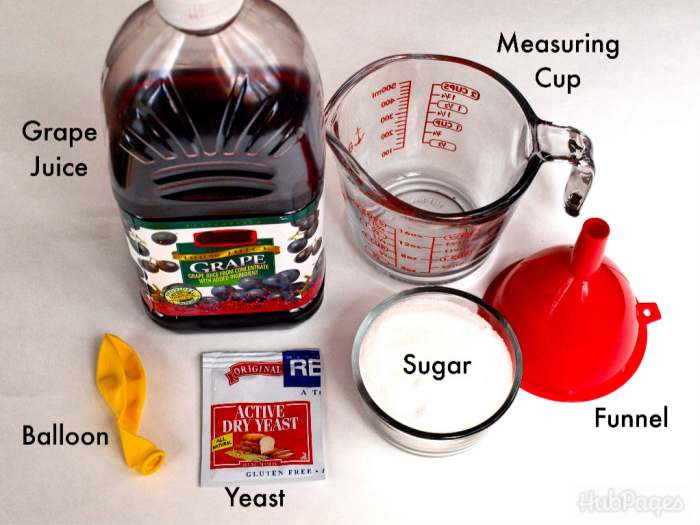How to Make Homemade Wine?
I made my own wine from the comfort of my home. It took a lot less time than I expected and it tasted great!

Making wine at home is easier than you think! Read on to learn how you can make your own red or white wine at home.
Homemade Wine Tutorial
It can be just as fun to brew homemade wine as to drink it. Brewing wine can fill you with knowledge and pride and is a whole lot of fun. It's also not nearly as difficult as it looks. Read on to find out how to make your own delicious wine. This recipe is pretty hard to mess up and only produces about 2.5 liters/quarts roughly, which, in my humble opinion, is the perfect starting amount.
Though this is a winemaking tutorial, if you want to get into making beer, I still would suggest starting here. Making wine is easier than making beer, and the following recipe is pretty inexpensive. All the ingredients can be found at your local grocery store, which means no need to buy any special brewing equipment, special yeast, or some expensive kit. And if you're a smart shopper, I would be willing to bet you can get it all (if you don't already have some things) for $15 or less.
What You Need for Making Wine
Ingredients
- 1 1/2 to 2 cups sugar
- 1 packet yeast (No need for anything fancy: Fleischmann's ActiveDry works just fine. You can find these packets in the baking aisle.)
- 1/2 gallon grape juice (This is where your own preferences come in. If you want to make a red wine, buy purple grape juice. For white wine, buy white grape juice. And if you want to make something interesting try any other kind of fruit juice that catches your fancy. Important note: Make sure the juice is pasteurized and has no preservatives, which will kill the yeast.)
Equipment
- Measuring cup
- Funnel
- Balloon (If you can't find any balloons at the grocery store, a condom works in a pinch: just make sure it's unlubricated!)
Editor Note: The rubber and latex can leach into the grape juice. A suitable alternative would be a winemaking airlock.
Instructions: Making Wine the Easy Way
- Wash everything thoroughly in hot water. This is basically the only thing you can do wrong. If your brew gets contaminated, you can't drink it.
- Pour out between 3/4 and 1 cup of the grape juice. I know it sounds counter-intuitive, but trust me it must be done to make room for the ingredients you'll be adding.
- Add 1.5 cups of sugar into the grape juice. If you want the wine to be less alcoholic, add 1 cup; and if you want the wine to be more alcoholic, add 2 cups. Then screw the cap back on tight and shake that bottle like you're doing some crazy dance from the '80s and you really want to impress your date. Do this for about a minute, or until you think the sugar is pretty well dissolved.
- Add one yeast packet. You don't need to use the funnel for this but you can if you want. There's no need to be stingy with yeast—it's the cheapest part of this whole project so don't try to make it last.
- Wait 5 minutes. Give the yeast time to moisten. After that do another vigorous shake for 10 or 15 seconds and be excited that you're almost done with the hard part.
- Place the balloon over the top of the bottle. The bottle should be uncapped and it should look like the picture below. Then poke 1–2 pin-sized holes in the bottom third of the balloon (area closest to the top of the bottle).
The balloon works as an airlock. If you want to get fancy, you can purchase a real, professional airlock online for cheap, but it's also possible to brew wine without one. I also take the extra step of using fishing line to tie the balloon to the bottle just in case, but it's not necessary.
When the little yeasty beasties are inside, they eat the sugar and poop out carbon dioxide and alcohol. We want the alcohol, but not carbon dioxide. If we capped the bottle, the pressure inside the bottle would build until either the bottle exploded or the carbon dioxide killed the yeast. I don't think you want to find out which would happen first, so I wouldn't try it if I were you!
What's Next? Wait for the Homemade Wine to Ferment
Take your bottle of soon-to-be wine, and store it in a cool dark place (the yeast like it there). After a couple of hours, check and see if your balloon has inflated. If it hasn't, you might try gently sloshing the mixture or just continue waiting. If your balloon does look inflated (or is inflating) then you're well on your way to a marvelous batch of wine. Just keep it stored in a cool dark place. Over the next couple of weeks, the wine will bubble, and biochemical reactions will take place.
What Goes Up, Must Come Down: Drinking and Storing Homemade Wine
After a few weeks, the yeast will eventually die off and thus stop producing carbon dioxide, causing the balloon to deflate. At that point, you're almost done! Just take the bottle to your kitchen and decide whether you would prefer to either:
- Drink it as is. At this step, your wine is ready to drink. Just pour yourself a glass and enjoy. However, make sure you don't drink the very bottom where all that sediment is. That stuff is nasty. I also advocate refrigerating it. It's not strictly necessary, but if you're not going to drink it all at once, it's a good way to make sure some bad bacteria don't get to it.
- Bottle it. For this, you're going to need an empty wine bottle and a whole other tutorial.



Comments
Post a Comment